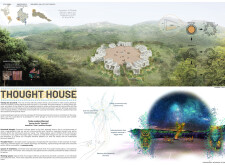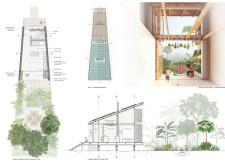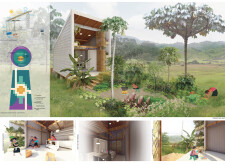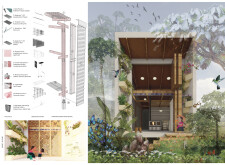5 key facts about this project
### Project Overview
Located in the Sibundoy Valley of Colombia, the "Thought House" design addresses the housing needs of the indigenous Kamentza community while integrating cultural heritage and biodiversity. The intent is to create a living environment that promotes communal living, introspection, and connectivity with nature, aligning social and environmental sustainability within its architectural framework.
### Spatial Organization and Community Interaction
The design features a circular layout of micro-homes, encapsulating the values of unity and equality. Each housing unit is oriented toward a central communal area, which acts as the focal point for gatherings, cultural exchanges, and community activities. This organization promotes cohesiveness among residents, mitigating the hierarchies typically associated with linear housing designs. The flexible spatial configurations of the units accommodate various needs, including:
- **Cooking and Dining Areas**: Shared spaces that promote communal meal preparation and consumption.
- **Sleeping Quarters**: Designed for individual families, these spaces are adaptable to various uses.
- **Workspaces**: Multifunctional areas that support local artisans and professionals.
### Material Selection and Sustainability
The choice of materials in the "Thought House" emphasizes local craftsmanship and environmental responsiveness. Notable materials include:
- **Quaducon™ Insulated Roof Panels**: Enhancing thermal performance and weather durability.
- **Acoustic Ceiling Tiles**: Improving sound insulation within shared spaces.
- **Natural Wood Structures**: Sustainably sourced wood that reflects local building traditions.
- **Insulated Wall Panels**: Promoting energy efficiency and comfort.
- **Eco-Friendly Finishes (Plywood)**: Locally sourced and non-toxic, contributing to a healthier living environment.
- **Rainwater Harvesting System**: An innovative approach to water conservation that underscores ecological stewardship.
These materials not only fulfill functional requirements but also resonate with the cultural heritage of the Kamentza community, providing both aesthetic coherence and symbolic significance within the living spaces.





















































